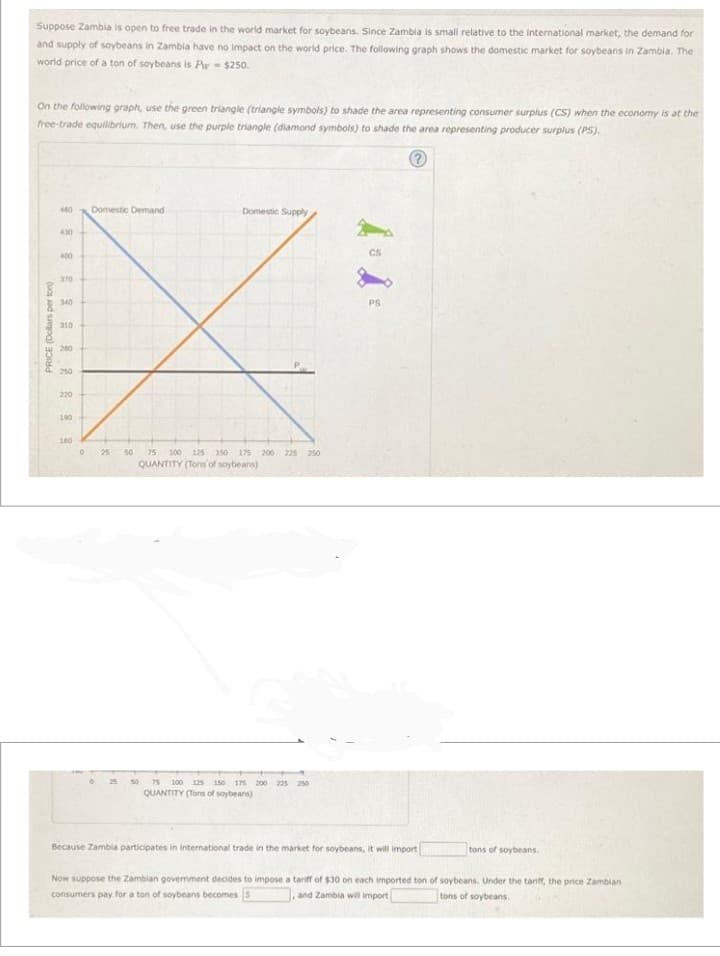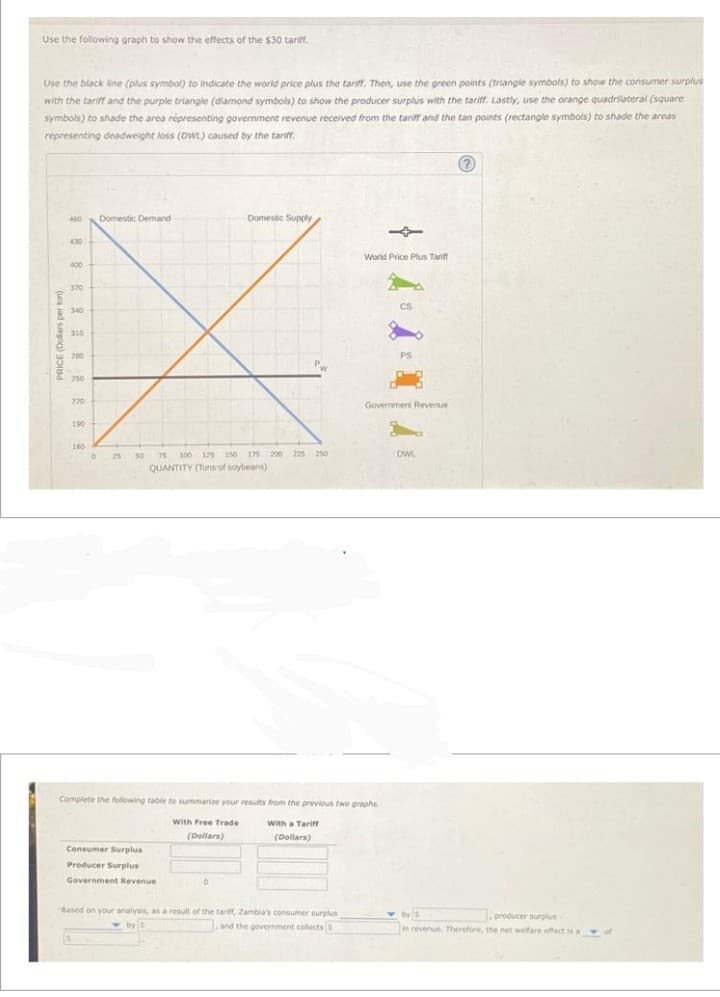Suppose Zambia is open to free trade in the world market for soybeans. Since Zambia is small relative to the international market, the demand for and supply of soybeans in Zambia have no impact on the world price. The following graph shows the domestic market for soybeans in Zambia. The world price of a ton of soybeans is Pir- $250. On the following graph, use the green triangle (triangle symbols) to shade the area representing consumer surplus (CS) when the economy is at the free-trade equilibrium. Then, use the purple triangle (diamond symbols) to shade the area representing producer surplus (PS). ? PRICE (Dollars per ton) 440 430 400 370 340 310 200 250 220 190 Domestic Demand Domestic Supply PS
Suppose Zambia is open to free trade in the world market for soybeans. Since Zambia is small relative to the international market, the demand for and supply of soybeans in Zambia have no impact on the world price. The following graph shows the domestic market for soybeans in Zambia. The world price of a ton of soybeans is Pir- $250. On the following graph, use the green triangle (triangle symbols) to shade the area representing consumer surplus (CS) when the economy is at the free-trade equilibrium. Then, use the purple triangle (diamond symbols) to shade the area representing producer surplus (PS). ? PRICE (Dollars per ton) 440 430 400 370 340 310 200 250 220 190 Domestic Demand Domestic Supply PS
Principles of Macroeconomics (MindTap Course List)
7th Edition
ISBN:9781285165912
Author:N. Gregory Mankiw
Publisher:N. Gregory Mankiw
Chapter9: Application: International Trade
Section: Chapter Questions
Problem 8PA
Related questions
Question

Transcribed Image Text:Suppose Zambia is open to free trade in the world market for soybeans. Since Zambia is small relative to the international market, the demand for
and supply of soybeans in Zambia have no impact on the world price. The following graph shows the domestic market for soybeans in Zambia. The
world price of a ton of soybeans is P - $250.
On the following graph, use the green triangle (triangle symbols) to shade the area representing consumer surplus (CS) when the economy is at the
free-trade equilibrium. Then, use the purple triangle (diamond symbols) to shade the area representing producer surplus (PS).
?
PRICE (Dollars per ton)
460 Domestic Demand
430
400
370
340
310
200
250
220
190
160
0 25
50
Domestic Supply
75 100 125 150 175 200 225 250
QUANTITY (Tons of soybeans)
75 100 125 150 175 200 225 250
QUANTITY (Tons of soybeans)
PS
Because Zambia participates in international trade in the market for soybeans, it will import
Now suppose the Zambian government decides to impose a tariff of $30 on each imported ton of soybeans. Under the tariff, the price Zambian
consumers pay for a ton of soybeans becomes
and Zambia will import
tons of soybeans.
tons of soybeans.

Transcribed Image Text:Use the following graph to show the effects of the $30 tariff.
Use the black line (plus symbol) to indicate the world price plus the tariff. Then, use the green points (triangle symbols) to show the consumer surplus
with the tariff and the purple triangle (diamond symbols) to show the producer surplus with the tariff. Lastly, use the orange quadrilateral (square
symbols) to shade the area répresenting government revenue received from the tariff and the tan points (rectangle symbols) to shade the areas
representing deadweight loss (DWL) caused by the tariff.
PRICE (Dollars per ton)
$ 8 8 2 2 2 8 8 8 8 8
460
400
370
340
310
200
250
220
15
190
160
0
Domestic Demand
25
50 75
100 125
125 150
QUANTITY (Tons of soybeans)
Consumer Surplus
Producer Surplus
Government Revenue
Domestic Supply
175 200 225
0
P
225 250
Complete the following table to summarize your results from the previous two graphs
With Free Trade
(Dollars)
With a Tariff
(Dollars)
Based on your analysis, as a result of the tariff, Zambia's consumer surplus
by s
and the government collects
4
World Price Plus Tariff
CS
PS
Government Revenue
DWL
(?)
by S
producer surplus
in revenue. Therefore, the net welfare effect is a of
Expert Solution
This question has been solved!
Explore an expertly crafted, step-by-step solution for a thorough understanding of key concepts.
This is a popular solution!
Trending now
This is a popular solution!
Step by step
Solved in 5 steps with 10 images

Knowledge Booster
Learn more about
Need a deep-dive on the concept behind this application? Look no further. Learn more about this topic, economics and related others by exploring similar questions and additional content below.Recommended textbooks for you

Principles of Macroeconomics (MindTap Course List)
Economics
ISBN:
9781285165912
Author:
N. Gregory Mankiw
Publisher:
Cengage Learning

Principles of Economics, 7th Edition (MindTap Cou…
Economics
ISBN:
9781285165875
Author:
N. Gregory Mankiw
Publisher:
Cengage Learning

Principles of Microeconomics
Economics
ISBN:
9781305156050
Author:
N. Gregory Mankiw
Publisher:
Cengage Learning

Principles of Macroeconomics (MindTap Course List)
Economics
ISBN:
9781285165912
Author:
N. Gregory Mankiw
Publisher:
Cengage Learning

Principles of Economics, 7th Edition (MindTap Cou…
Economics
ISBN:
9781285165875
Author:
N. Gregory Mankiw
Publisher:
Cengage Learning

Principles of Microeconomics
Economics
ISBN:
9781305156050
Author:
N. Gregory Mankiw
Publisher:
Cengage Learning

Essentials of Economics (MindTap Course List)
Economics
ISBN:
9781337091992
Author:
N. Gregory Mankiw
Publisher:
Cengage Learning


Principles of Economics 2e
Economics
ISBN:
9781947172364
Author:
Steven A. Greenlaw; David Shapiro
Publisher:
OpenStax